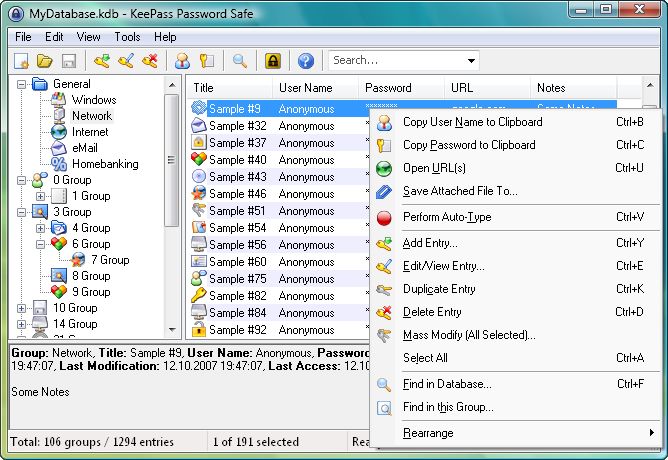
KEEPASS. CODE
Take care, the plugins willĮxecute their code with the same privilege level of the KeePass process.įind below the way to change the location of the cache folder:
KEEPASS. UPDATE
Privileges with each update to let it compile them. In any case, KeePass should be run with administrative The default path to the cache folder can be changed using the PluginCachePath key in theĬonfiguration file. As explained, in the Plugin Cache section, Otherwise, you can use another folder that isn't writable for the current The Write permission of the cache folder should be adjusted as The PluginCache folder is in %LocalAppData%\KeePass, which is owned by theĬurrent user. To file permission being too permissive: fix the permissions and do not use MitigationĪt least, there are two ways to deal with the issue that is ultimately related Which is a tool to automate KeePass discovery and secret extraction. The KeePassXml2x.Export method that saves the database in plain XML format. Is a standalone DLL using an easier way to export a KeePass databases. PS C :\> get-acl "C:\Users\$env:UserName\AppData\Local\" | > select -expand access | > ? Permissions is given in the official documentation. The permission mapping between generic access rights and file Only inherits the GENERIC_READ and GENERIC_EXECUTE permission concerning the Users The following PowerShell command confirms that a sub-folder of %ProgramFiles% Isn't writable by users meaning that a plugin can't be registered by a user. The %ProgramFiles% folder with administrative rights. To restrict access to the Plugins folder, KeePass can be installed in The compiled librariesĪre stored in a folder called PluginCache, from which they are loaded atĪll details about the format are documented in theĪs long as KeePass can load plugins, then it can be easy to load a malicious pluginīy registering one in the Plugins folder (located in the application PLGX is an object-oriented file format that contains all information needed toĬompile the plugin with the version of KeePass to a DLL. (called PLGX) is available to address this potential issue.

Version of KeePass that was used to build it. This kind of plugin format canĬause a crash because of an API change, since the plugin depends on the Library (DLL) containing the managed assembly. PLGX PluginĪ KeePass plugin is developed in C#. Mitigation now written in the plugins page in the Security section. If you need strongĬompatibility, you can keep using PLGX plugins but you should follow the clear The DLL format is better from a security point of view. This blog post is written after reporting and discussing the issue with Mitigations are given for those worried about the security of the plugin cache. Process, even if KeePass is installed with administrative rights on Windows. This blog post presents a way to abuseĪ mechanism related to this format to load arbitrary code in the KeePass A list of available plugins is givenĪccording to the Plugin Development (2.x) page,Īs a plugin depends on the version of KeePass during the build, an optional pluginįile format (called PLGX) was created. The cloud, supply credentials through a network protocol, add anĪdditional import/export format and so on.

That allows developers to extend its features like backup the local database to All details about KeePass security are written in the
KEEPASS. GENERATOR
Password generator and a local database where passwords are stored encrypted Popular operating systems (Linux, macOS, and Microsoft Windows).
KEEPASS. FREE
KeePass is a well-known free open-source password Managers try to prevent extraction of the passwords they store locally (or on the cloud for those using that). The attacker compromise all the user's accounts. Unfortunately, a password manager is an attractive target forĪttackers, as extracting the passwords stored in the password manager will let The passwords stored in the application, meaning that only one secret should be Password managers are programs/apps that help users by generating passwords and NIST Special Publication 800-63B, Appendix A - Strength of Memorized Secrets. More details about "strong password" are available in the Randomly generated password for each service, and store them in a password To avoid that, a good practice for users is to pick a strong, As a result, all the user's accounts that use Salted password hash, as it is the recommended way to store passwords.

For example, ifĪny of these websites has a data breach, then an attacker can retrieve a Multiple services for simplicity, which is considered bad practice. Most users create weak or predictable passwords and reuse them across Is often predictable) and a password (which is something to keep Today, users have a lot of online accounts. It is performed by abusing the cache resulting from the compilation of PLGX plugin. This blog post presents a post-exploitation approach to inject code into KeePass without process injection.


 0 kommentar(er)
0 kommentar(er)
